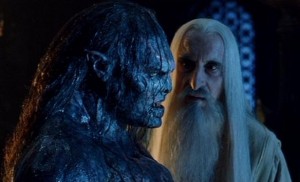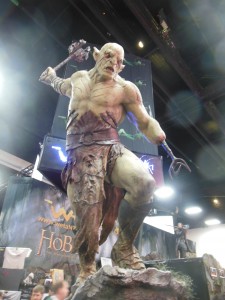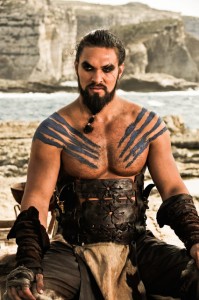AZOG’S PHYSICAL DEPICTION

It was clear that prosthetics could work, including the full-body skin suits that were used for Lurtz in Fellowship of the Ring. However all of this can be argued but the following theory requires some reading between the lines of the publicity machine.
Azog was nowhere to be seen in trailers or production diaries. He could have been a very well kept secret but WETA Digital in their online featurette explain how:
“Azog was one of the last characters on The Hobbit to get design approval. Originally cast as an actor in prosthetics, Peter Jackson decided that Azog really needed to stand out from the rest of the orcs, so Azog became the seven-foot pale orc we see in the film. This meant a very condensed time frame to bring him up to scratch.”

To me, this sounds like those shots would have to do because they didn’t have the time to let the character design evolve and start feeling right.
Was the whole process rushed for Azog?
Is that why the final product unfortunately reminds me of a video game boss, rather than a believable character such as Gollum?
The Trolls and the Goblin King looked fantastic because the team had plenty of time to refine them. You almost forget about Gollum being a CG character because he’s so seamlessly created. By contrast, Azog appears almost as an afterthought, inserted to provide An Unexpected Journey with a Lurtz that it sorely lacked. The life-size statue of Azog at this year’s San Diego Comic-Con adds weight to the argument that he looks much better in real life, but because they simply ran out of time, that wasn’t an option.
GAME OF THRONES INFLUENCE?

Elves and Men used a well-spoken neutral English accent. Most Hobbits spoke with West Country English or Scottish accents. Even the Corsairs of Umbar, as briefly as they were depicted, spoke with a Northern English accent. Of course there are some exceptions to this but as a whole they remain consistent and more importantly established in our minds.
(A note on of the Dwarves accents: because Gimli was the only dwarf to speak in LOTR, they had a lot more flexibility to expand on these so within The Hobbit we get Northern English, Scottish and even Northern Irish accent (much akin to my own!))
The orcs of The Lord of the Rings movies spoke with Cockney accents. It was consistent throughout the films amongst Isengard and Mordor orcs. It allowed the actors to use an accent that has the ability to come across as rough and aggressive. This was so effectively established that even though they never actually speak, one can imagine the Moria goblins speaking the same way. Why then change this trend in The Hobbit? What was wrong with the Cockney of the orcs in The Lord of the Rings films? It is possible that they chose not to depict the Cockney accent so consistently in a negative light this time round, but I have another theory to explain the change.
This is entirely my own opinion, but it seems that opting for Black Speech could’ve been an imitation of the Dothraki from the Game of Thrones TV series. The Dothraki, for those who are unfamiliar, are a horde of barbaric horselords with their own guttural language (also called Dothraki).
Their leader, Khal Drogo, gives some very aggressive speeches, made all the more intimidating by the sound of this harsh-sounding Dothraki language. Could this have inspired the AUJ filmmakers to go in the same direction with their new orcs? Especially seeing as Tolkien’s world is built primarily on his languages. Even the physical depiction of Azog is somewhat reminiscent of Khal Drogo with the exposed upper body with no armour. That, added with Azog speaking Black Speech, presents some striking similarities.
Compare these two scenes and try not to see the similarities between these two characters.
[Khal Drogo Speech] | [Azog Gets Angry]
Early in my watching of AUJ, I noticed that reading the subtitles and watching Azog’s face was a bit of a distraction. I have nothing against subtitles, I just found that on top of a character that was visually not as strong as one would hope, this was yet another distraction. I found myself unable to see the little nuances in the digital performance because I was reading. This usually isn’t an issue with live action performances because our eyes are accustomed to pick up these nuances in human faces even at a glance.
Azog however is an unfamiliar non-human face with slightly different expressions that I feel require a little more attention for the audience to be able to appreciate fully. The use of Black Speech was another detail that distracts the audience. I very feel that the cockney accents would’ve worked here and would fit in a lot more with what has already been established within Peter Jackson’s universe.


